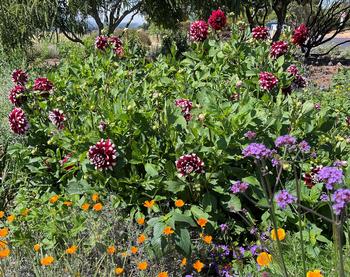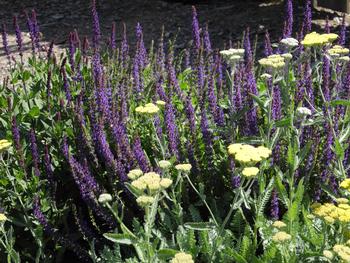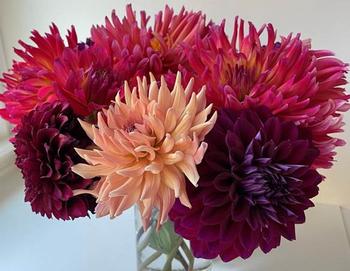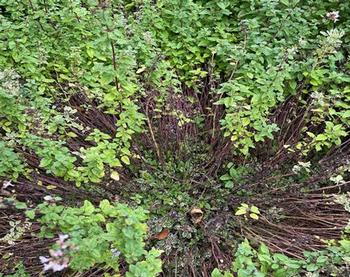
Dahlias form tuberous roots, which need to be divided when they get big and crowded. Photo: Anne-Marie Walker
Are your perennials looking overgrown, crowded, producing fewer blooms or growing bald spots? If so, it is likely time to dig up that plant, divide it into smaller clumps, and re-plant. Division is one method of asexual propagation accomplished by separating a multi-crowned perennial plant into separate plants. Dividing and re-planting a perennial makes more space for roots to grow. By fall, many spring and summer blooming perennials are fading, have peaked on growth, and are ready for invigorating division. A divided plant can absorb more water and nutrients. Division not only sustains your garden but is also a sustainable practice, as rains will come soon to Marin. While some perennials do not like to be divided, including Digitalis (foxglove), Helleborus (hellebore), Lupinus (lupine), Lavandula (lavender), Rosmarinus officinalis (rosemary) and Aquilegia (columbine), many other garden plants are invigorated when divided. These include Achillea (yarrow), Asters, Campanula (bellflower), Chrysanthemum, Lobelia, Penstemon, Sedum (stonecrop), and even some perennial edible plants including Alliums (onions), Rheum rhabarbarum (rhubarb) and many herbs.

Anise Hyssop and Yarrow are both herbs that benefit from division when they get too woody. Photo: Anne-Marie Walker
On a fabulous fall day, water the perennial plant you have selected to divide and then remove faded blossoms and yellowed leaves. Prune foliage moderately to reduce transpiration (evaporative water vapor loss from leaves). Carefully dig around the plant to release as much of the root ball as possible. Pull the plant from the soil, shake off the loose soil, and turn it upside down. What follows next will vary because perennial plants have different types of root systems requiring different treatments. Asters, Monarda (bee balm), Stachys byzantina (lamb’s ear), Echinacea purpurea (Purple cone-flower), and Chrysanthemum all have spreading root systems which can be eased apart by hand or cut apart with clippers or a garden knife. You can divide spreading root systems by placing two digging forks back to back and prying them apart. Clumping root systems originate from a central clump with multiple growing points and thick, fleshy roots. Examples include Hemerocallis (daylily), Heuchera (Coral Bells), Agapanthus (Lily of the Nile), and Kniphofia uvaria (red-hot-poker).

Dahlias form tuberous roots which need to be divided when they get big and crowded. Photo: Anne Marie Walker
The best way to divide these is to cut through the crown with a sharp, heavy garden knife, leaving at least one developing bud on each division. Perennials with rhizome root systems are easily identified by stems that grow horizontally at or above ground level. Bearded irises, Cannas and Zantedeschia aethiopiea (Cala Lily), and Convallaria majalis (lily of the valley) are some of the most commonly grown ornamental perennials with rhizomatous root systems. To divide rhizomatous perennials, retain a few inches of rhizome and one fan of leaves trimmed back halfway. Again, remember to retain at least one bud on the piece of crown you are re-planting. To divide perennials with tuberous roots (like dahlias), cut the tuber with a sharp knife, keeping at least one bud and a portion of the original stem (tuber). Marin’s climate is warm enough that dahlias, native to the Americas, can be left in the ground. But, when tubers grow large, get crowded, and do not produce favorable blooms, they benefit from division.

Oregano is a perennial edible herb with a spreading root system. Division invigorates the plant & controls spread. Photo: Anne-Marie Walker
As you divide perennials, discard the older, course center growth and keep the fresh divisions moistened. Prep planting beds and containers with compost and soil amendments and plant the divisions immediately at the same depth they were originally. Firm the soil around the roots to eliminate air pockets, mulch, and water well. Follow up with fertilizer one week after planting. Dividing plants in autumn allows plants to grow roots while the soil is still warm, invigorates a mature plant, keeping it looking good, and uses water sustainably; let the winter rains do the work. You can also have some fun filling out areas of your garden and sharing extra plants with friends.
 Dahlias form tuberous roots, which need to be divided when they get big and crowded. Photo: Anne-Marie WalkerOn a fabulous fall day, water the perennial plant you have selected to divide and then remove faded blossoms and yellowed leaves. Prune foliage moderately to reduce transpiration (evaporative water vapor loss from leaves). Carefully dig around the plant to release as much of the root ball as possible. Pull the plant from the soil, shake off the loose soil, and turn it upside down. What follows next will vary because perennial plants have different types of root systems requiring different treatments. Asters, Monarda (bee balm), Stachys byzantina (lamb’s ear), Echinacea purpurea (Purple cone-flower), and Chrysanthemum all have spreading root systems which can be eased apart by hand or cut apart with clippers or a garden knife. You can divide spreading root systems by placing two digging forks back to back and prying them apart. Clumping root systems originate from a central clump with multiple growing points and thick, fleshy roots. Examples include Hemerocallis (daylily), Heuchera (Coral Bells), Agapanthus (Lily of the Nile), and Kniphofia uvaria (red-hot-poker).
Dahlias form tuberous roots, which need to be divided when they get big and crowded. Photo: Anne-Marie WalkerOn a fabulous fall day, water the perennial plant you have selected to divide and then remove faded blossoms and yellowed leaves. Prune foliage moderately to reduce transpiration (evaporative water vapor loss from leaves). Carefully dig around the plant to release as much of the root ball as possible. Pull the plant from the soil, shake off the loose soil, and turn it upside down. What follows next will vary because perennial plants have different types of root systems requiring different treatments. Asters, Monarda (bee balm), Stachys byzantina (lamb’s ear), Echinacea purpurea (Purple cone-flower), and Chrysanthemum all have spreading root systems which can be eased apart by hand or cut apart with clippers or a garden knife. You can divide spreading root systems by placing two digging forks back to back and prying them apart. Clumping root systems originate from a central clump with multiple growing points and thick, fleshy roots. Examples include Hemerocallis (daylily), Heuchera (Coral Bells), Agapanthus (Lily of the Nile), and Kniphofia uvaria (red-hot-poker). Anise Hyssop and Yarrow are both herbs that benefit from division when they get too woody. Photo: Anne-Marie WalkerThe best way to divide these is to cut through the crown with a sharp, heavy garden knife, leaving at least one developing bud on each division. Perennials with rhizome root systems are easily identified by stems that grow horizontally at or above ground level. Bearded irises, Cannas and Zantedeschia aethiopiea (Cala Lily), and Convallaria majalis (lily of the valley) are some of the most commonly grown ornamental perennials with rhizomatous root systems. To divide rhizomatous perennials, retain a few inches of rhizome and one fan of leaves trimmed back halfway. Again, remember to retain at least one bud on the piece of crown you are re-planting. To divide perennials with tuberous roots (like dahlias), cut the tuber with a sharp knife, keeping at least one bud and a portion of the original stem (tuber). Marin’s climate is warm enough that dahlias, native to the Americas, can be left in the ground. But, when tubers grow large, get crowded, and do not produce favorable blooms, they benefit from division.
Anise Hyssop and Yarrow are both herbs that benefit from division when they get too woody. Photo: Anne-Marie WalkerThe best way to divide these is to cut through the crown with a sharp, heavy garden knife, leaving at least one developing bud on each division. Perennials with rhizome root systems are easily identified by stems that grow horizontally at or above ground level. Bearded irises, Cannas and Zantedeschia aethiopiea (Cala Lily), and Convallaria majalis (lily of the valley) are some of the most commonly grown ornamental perennials with rhizomatous root systems. To divide rhizomatous perennials, retain a few inches of rhizome and one fan of leaves trimmed back halfway. Again, remember to retain at least one bud on the piece of crown you are re-planting. To divide perennials with tuberous roots (like dahlias), cut the tuber with a sharp knife, keeping at least one bud and a portion of the original stem (tuber). Marin’s climate is warm enough that dahlias, native to the Americas, can be left in the ground. But, when tubers grow large, get crowded, and do not produce favorable blooms, they benefit from division. Dahlias form tuberous roots which need to be divided when they get big and crowded. Photo: Anne Marie WalkerAs you divide perennials, discard the older, course center growth and keep the fresh divisions moistened. Prep planting beds and containers with compost and soil amendments and plant the divisions immediately at the same depth they were originally. Firm the soil around the roots to eliminate air pockets, mulch, and water well. Follow up with fertilizer one week after planting. Dividing plants in autumn allows plants to grow roots while the soil is still warm, invigorates a mature plant, keeping it looking good, and uses water sustainably; let the winter rains do the work. You can also have some fun filling out areas of your garden and sharing extra plants with friends.
Dahlias form tuberous roots which need to be divided when they get big and crowded. Photo: Anne Marie WalkerAs you divide perennials, discard the older, course center growth and keep the fresh divisions moistened. Prep planting beds and containers with compost and soil amendments and plant the divisions immediately at the same depth they were originally. Firm the soil around the roots to eliminate air pockets, mulch, and water well. Follow up with fertilizer one week after planting. Dividing plants in autumn allows plants to grow roots while the soil is still warm, invigorates a mature plant, keeping it looking good, and uses water sustainably; let the winter rains do the work. You can also have some fun filling out areas of your garden and sharing extra plants with friends. Oregano is a perennial edible herb with a spreading root system. Division invigorates the plant & controls spread. Photo: Anne-Marie Walker
Oregano is a perennial edible herb with a spreading root system. Division invigorates the plant & controls spread. Photo: Anne-Marie Walker



